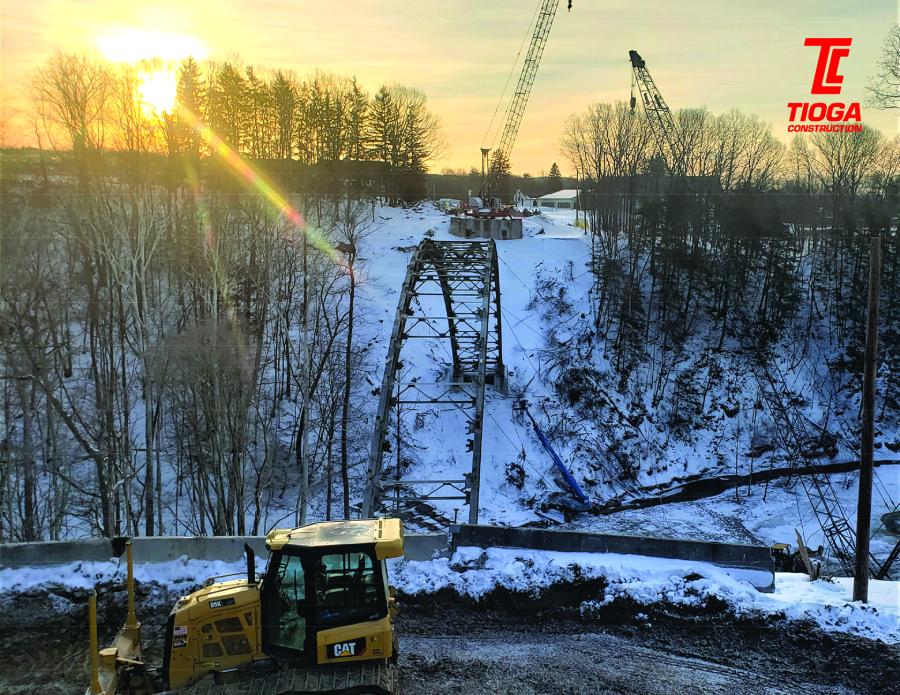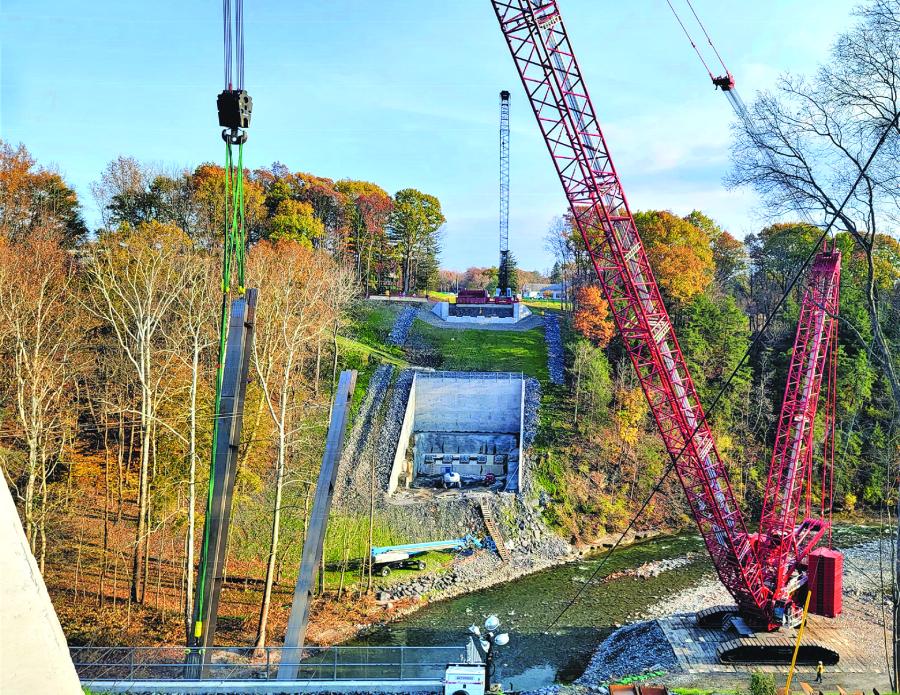The piers were considered “Mass Placement” and required a thermal control plan and temperature regulating system be designed, and temperatures monitored and recorded internally throughout curing.
Crews from Tioga Construction began a $17.5 million New York State Department of Transportation's (NYSDOT) project to demolish and replace the Route 34B bridge over the Salmon River, which carries traffic in and out of the city of Ithaca, home to the famed Cornell University.
The 500-ft. long three-span steel arch bridge (two-lanes in each direction) was built in 1930 in Tompkins Count and is close to several schools, farm fields, a county park and a marina. The new bridge, built on the same alignment is, 500 ft. long, 40 ft. wide and sits 120 ft. above the river. It is based on a slant leg rigid frame design.
The project will replace a structure with a modern span featuring a concrete bridge deck supported by steel girders and piers, offering 12-ft.-wide travel lanes and 8-ft.-wide shoulders. The additional width will provide more room for pedestrians, cyclists and disabled vehicles.
Daily traffic on the bridge is more than 7,700 cars and trucks.
Construction started in November 2020 with the demolition of the old bridge and with the substructure complete, crews are getting ready to set the steel for the superstructure. They have finished placing and installing a Manitowoc MLC650 VPC-MAX lattice boom crawler crane to lift and set the steel.
Tioga secured the contract on Oct. 10, 2020, and the delivery date for the new bridge is March 1, 2022. The project is being funded by federal and state dollars and is part of the Statewide Transportation Improvement Program (STIP), which is a list of every project in New York State for which federal funding is proposed to be used and that is scheduled to begin during the designated three federal fiscal year time frame.
The old bridge had exceeded its allotted lifespan.
"Built in 1930, the bridge was in a condition that necessitated a replacement," said Curtis Jetter, NYSDOT Region 3 public information officer. "Bridge design started in May 2010. The bridge is a vital connection for commuters, tourists and commerce in Tompkins County, just north of the city of Ithaca. Route 34B is a vital roadway in the Cayuga Lake Wine trail that traverses the eastern shores of Cayuga Lake. The bridge is also on an important bus route for Tompkins Consolidated Area Transit, as well as for the Lansing Central School District, as district schools are located just south of the bridge."
The new bridge was designed by NYSDOT and is expected to have a 75-year lifespan.
With the bridge demolished, traffic was detoured to ensure that Tioga had sufficient space to build the new structure.
"There are no issues with the detour route," said Jetter. "NYSDOT closed Route 34B from Myers Road to the bridge on both sides of the bridge. This gives the contractor approximately 750 feet on the east side of the bridge to store equipment and materials and gives them approximately 350 feet on the west side of the bridge. The west side also accommodates three properties with local access. The contractor has purchased property on the southwest corner of the site. They built an access road down to the bottom of the ravine in order to stage their operations from there."
Ryan Day, Tioga Construction's project engineer, has overseen many bridge projects and does not leave anything to chance.
"Demolition and steel erection were the major challenges," he said. "The condition of the existing steel components, along with the stability of the piers and arches during concrete deck slab removal, were critical in the planning and execution of the multi-phase demolition plan. Access was an issue in the planning of the erection procedure.
"Progress has been steady and will continue through winter until steel erection is complete. Our main access road and a majority of our laydown areas are on the north end of the project.
"There is a middle school immediately to the southeast of the project and the vertical grade at the southwest corner of the project is too steep to access.
"Relations with NYSDOT have been great. The DOT has been very responsive to any issues that arise and resolutions are quick."
Safety is an ever-present issue.
"Similar to all bridge construction projects, fall safety is a major point of emphasis and training," said Day. "Work platforms and safety controls through engineering have also been implemented. As we get closer to winter months, frost and icy conditions will add to the list of hazards that our crews need to address. Stream restrictions during demolition were significant. All demolition was to be competed and no in-stream work was allowed after March 8, 2021. Salmon Creek is a Class C Trout Stream. NYSDEC was highly involved in all discussions and submittals regarding in-stream work."
The old bridge was demolished between mid-December 2020 and mid-February 2021.
"The plan was to remove the concrete deck completely before steel removal began," said Day. "One issue with the deck removal was that the approach spans were required to be removed prior to the removal of the center span. This was to prevent unbalanced loading of the pier blocks. This resulted in an access issue for the removal of the center span deck. We needed to access the center spans for concrete removal using temporary walkways mounted to the existing steel structure at span 1.
"Debris bins were used to catch debris while removing the concrete overhangs," he added. "The remainder of the deck was sawcut into manageable rectangular pieces and picked off with a crane. A poly sheeting system was installed to carry any slurry from below saw cutting and removal operations into appropriate areas beyond the creek bank. Steel was removed in segments until the center span remained.
"We originally planned on using explosives, but ultimately decided to remove the center span mechanically ourselves. Steel was processed and loaded out as it was removed from the bridge. We finished demolition ahead of schedule and well before the DEC stream restriction date."
Key pieces of equipment for the demolition included a Link-Belt HC-218A, a Link-Belt HC-238A and a Terex AC-350 hydraulic all-terrain crane from Rig-All Inc. in Frankfort, N.Y., and a Komatsu HM 400-S end dump
Construction of the substructure began in April 2021 and was completed in August 2021.
"The bridge abutments were pretty standard," said Day. "The piers were considered ‘Mass Placement' and required a thermal control plan and temperature regulating system be designed, and temperatures monitored and recorded internally throughout curing. We used concrete pumps to place the pier concrete due to their locations. Concrete trucks used the access road from the north end of the project to reach the pumps that were set up below. We were allowed to install a temporary causeway to access Pier 2 from the bottom of the gorge."
The setting of the steel should take six to eight weeks to complete.
"Crane assembly took about four days," said Day. "The crane came in on 49 tractor trailer loads of parts, boom sections and counterweight. We utilized Rig-All's 400-ton hydraulic crane to help assemble the 650 VPC. The crane's 300-foot boom and large capacity will allow us to install all girders from one location.
"The 650 VPC has 881,800 lbs. of counterweight and a 350-ton crane block with an 11 part line fall. There are various lengths of girder components. The legs are 89 feet long and the total length of the roadway girder assembly is 500 feet.
"The steel is arriving on site at a rate of about five to six girders per-week. There are 35 permitted girder shipments and an additional 10 loads of miscellaneous steel components."
The Structural Steel is fabricated by Canam Bridges in Claremont, N.H.
The pouring of the bridge deck is expected to begin in April and should take three days.
"Since the completion of steel erection won't be until winter, the DOT and Tioga plan to place the deck in April to avoid curing issues or placement delays due to temperatures," said Day. "Forming the deck in the winter would present additional safety issues, as well. After deck placement, the work remaining includes bridge approach slaps, sleeper slabs, armorless joint placement, blacktop placement, bridge barrier installation, guiderail, deck grooving and striping. Most of the grading, plantings and ditches have already been completed. The remainder of them that tie into the bridge structure will be completed in the spring."
Tioga's management team includes John Dillon, vice president and project manager; Jim Dillon, (demolition plan and erection procedure); Project Engineer Ryan Day; Superintendent Bill Vedder; and Superintendent Butch Amidon.
"Most of these members, as well as many crew members have worked together for 20 to 30 years or more," said Day. "Everyone is familiar with each other and willing to do what's necessary to get a project like this done. The crew on this job has done an excellent job throughout this project. Erecting steel like this in cold winter conditions isn't easy. We give our guys a lot of credit for always getting the job done, especially through rough weather conditions."
Peak days have 18 to 20 Tioga and subcontractor personnel. The major subcontractors include Interstate Reinforcing for furnish and installation of rebar, Keller North America for soil nail wall installation, KHM Incorporated for stabilization of rock slope with shotcrete, Northers Stud Welding for stud shear connectors and superstructure deck pans, Rommel Fence for pedestrian fencing around soil nail walls and Pavilion Drainage Supply for guiderail, transition rail and signage.
Other equipment being used includes a Komatsu PC 360LC-10 excavator, a Cat 930M loader, Genie SB1501 boom lifts and a Cat 336E excavator.
"Tioga employs full-time mechanics in addition to dealer mechanics," said Day. "Our head mechanic works both on site and at our maintenance facility in Schuyler, N.Y. He is on site as needed for standard maintenance as well as repairs."
Tioga purchases and rents equipment from Lomma Crane & Rigging in South Kearny, N.J.; Mac Equipment in Albany; Anderson Equipment in Syracuse; Milton CAT in Syracuse; and Tracey Road Equipment in Syracuse.
"Our dealers are very responsive and helpful with all aspects of equipment rental," said Day. "Our equipment manager, owners and project engineers have good relationships with our dealers through years of working cooperatively to utilize the correct size and capacity equipment for various size projects and tasks. They're an important asset in our industry." CEG
Irwin Rapoport
A journalist who started his career at a weekly community newspaper, Irwin Rapoport has written about construction and architecture for more than 15 years, as well as a variety of other subjects, such as recycling, environmental issues, business supply chains, property development, pulp and paper, agriculture, solar power and energy, and education. Getting the story right and illustrating the hard work and professionalism that goes into completing road, bridge, and building projects is important to him. A key element of his construction articles is to provide readers with an opportunity to see how general contractors and departments of transportation complete their projects and address challenges so that lessons learned can be shared with a wider audience.
Rapoport has a BA in History and a Minor in Political Science from Concordia University. His hobbies include hiking, birding, cycling, reading, going to concerts and plays, hanging out with friends and family, and architecture. He is keen to one day write an MA thesis on military and economic planning by the Great Powers prior to the start of the First World War.
Read more from Irwin Rapoport here.
Today's top stories




















